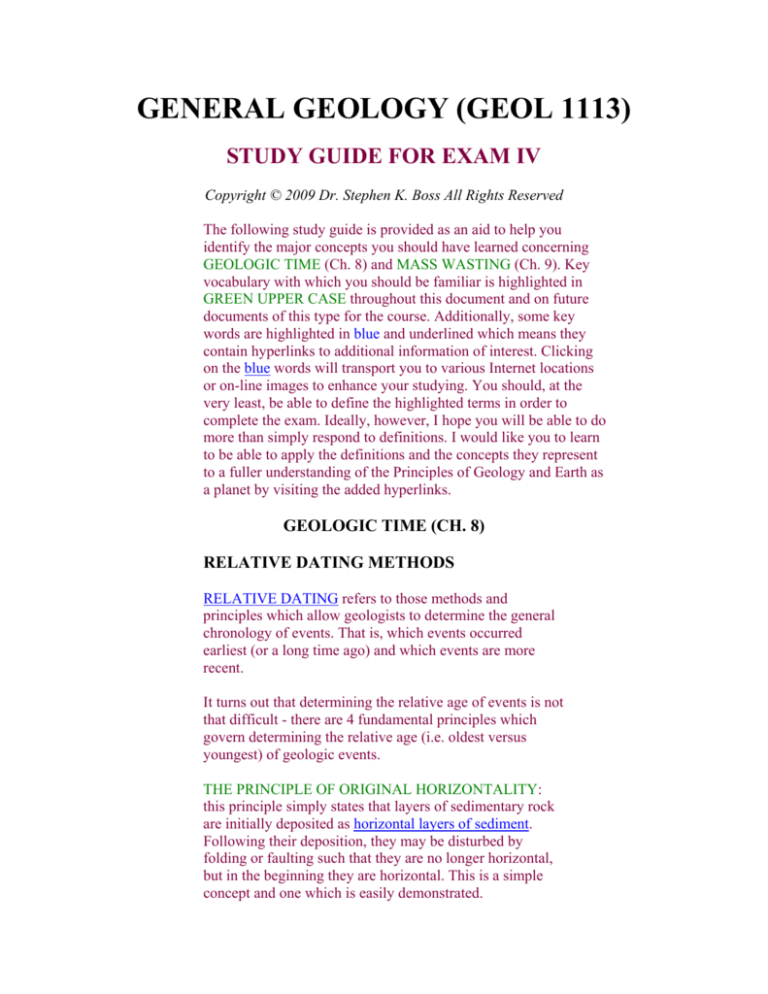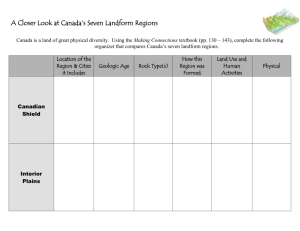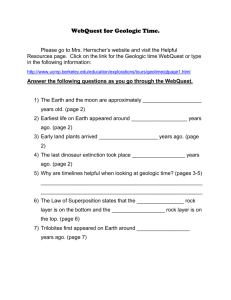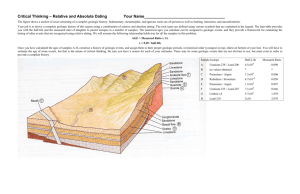
GENERAL GEOLOGY (GEOL 1113)
STUDY GUIDE FOR EXAM IV
Copyright © 2009 Dr. Stephen K. Boss All Rights Reserved
The following study guide is provided as an aid to help you
identify the major concepts you should have learned concerning
GEOLOGIC TIME (Ch. 8) and MASS WASTING (Ch. 9). Key
vocabulary with which you should be familiar is highlighted in
GREEN UPPER CASE throughout this document and on future
documents of this type for the course. Additionally, some key
words are highlighted in blue and underlined which means they
contain hyperlinks to additional information of interest. Clicking
on the blue words will transport you to various Internet locations
or on-line images to enhance your studying. You should, at the
very least, be able to define the highlighted terms in order to
complete the exam. Ideally, however, I hope you will be able to do
more than simply respond to definitions. I would like you to learn
to be able to apply the definitions and the concepts they represent
to a fuller understanding of the Principles of Geology and Earth as
a planet by visiting the added hyperlinks.
GEOLOGIC TIME (CH. 8)
RELATIVE DATING METHODS
RELATIVE DATING refers to those methods and
principles which allow geologists to determine the general
chronology of events. That is, which events occurred
earliest (or a long time ago) and which events are more
recent.
It turns out that determining the relative age of events is not
that difficult - there are 4 fundamental principles which
govern determining the relative age (i.e. oldest versus
youngest) of geologic events.
THE PRINCIPLE OF ORIGINAL HORIZONTALITY:
this principle simply states that layers of sedimentary rock
are initially deposited as horizontal layers of sediment.
Following their deposition, they may be disturbed by
folding or faulting such that they are no longer horizontal,
but in the beginning they are horizontal. This is a simple
concept and one which is easily demonstrated.
THE PRINCIPLE OF SUPERPOSITION: this principle
follows, in part, from the Principle of Original
Horizontality. It states that in any succession of
sedimentary rock layers, the layers near the bottom are the
oldest and the layers near the top are the youngest.
THE PRINCIPLE OF CROSS-CUTTING
RELATIONSHIPS: this principle is, perhaps, the most
difficult to visualize, but is also quite obvious. It states that,
in any geologic setting, the event or geologic feature which
cuts across the most other features is the youngest. This
derives from the fact that a geologic feature cannot be
cross-cut unless it already exists prior to the cross-cutting
event. Thus, the cross-cutting event is the youngest.
THE PRINCIPLE OF FAUNAL SUCCESSION: this
principle states that fossil organisms preserved in rock
layers become progressively less complex as rocks become
older. It is interesting to note this principle was formulated
in the early 1800’s, PRIOR to the time that CHARLES
DARWIN postulated his hypothesis of EVOLUTION in his
book, THE ORIGIN OF SPECIES (1859). (NOTE: the
links in this section will connect you with the University of
California Museum of Paleontology - one of the finest in
the world. I encourage you to spend some time browsing
their extensive web site - you will be amazed!)
It is also of interest to note
that the Principle of Faunal
Succession works as a means
of determining the relative
age of rocks. Regardless of
one’s personal belief as to
why organisms change
through time, it is an
established fact that they do
and this fact is useful to
geologists.
The SUCCESSION OF FOSSILS within sedimentary
layers as well as grouping or ASSEMBLAGES OF
FOSSILS in those rocks are used to bracket the relative
ages of rocks.
HISTORICAL GEOLOGY is the branch of geology that
deals with interpretation of the geologic history of Earth
and the timing of major events in Earth history.
Since 1795, when JAMES HUTTON presented his
THEORY OF THE EARTH, historical geologists have
been able to reconstruct a reasonable chronology of events
in our planets history. However, it is important to
understand that the history of our planet is INCOMPLETE
- just as there are geologic processes which PRESERVE
the planet’s history, there are also geologic processes which
DESTROY our planet’s history.
Gaps in the geologic record are referred to as
UNCONFORMITIES. Unconformities represent intervals
of time during which 1) no sediment was deposited in a
region and therefore, no geologic record was generated or
2) erosion in a region removed some portion of the
geologic record, creating a gap in the geologic record.
James Hutton
was the first
person to
describe an
angular
unconformity
at SICCAR
POINT
(SCOTLAND)
and recognize
that the
boundary
separating the
tilted layers
from the
horizontal
layers
represented an
extraordinary
amount of
time.
Observations
such as this
led Hutton
ultimately to
propose that
Earth might be
"millions" of
years old.
There is a large range in the amount of time represented by
unconformities. Some unconformities may represent only a
few years, while others exceed 1 billion years in duration.
When you step outside Ozark Hall, you are standing on a
hill composed of rocks that are about 320 million years old.
Thus, the “gap” between those rocks and the sole of your
shoe is an UNCONFORMITY; there is no geologic record
of events between the time the rocks on Old Main Hill
formed and the present year.
Unconformities are very important features of the geologic
history of Earth. Some estimates suggest that the preserved
history of Earth represented by layers of sedimentary rocks
might, in fact, be only 10% of Earth’s history. The
remaining 90% of Earth history is lost in unconformities.
By piecing together the geologic record from many
locations around the earth, geologists have been able to
construct a STANDARD GEOLOGIC TIME SCALE
which shows Earth’s history subdivided into EONS, ERAS,
PERIODS, and EPOCHS.
EONS are subdivisions of geologic time
with durations of BILLIONS OF YEARS.
ERAS are subdivisions of geologic time
with durations of HUNDREDS OF
MILLIONS OF YEARS.
PERIODS are subdivisions of geologic time
with durations of TENS OF MILLIONS OF
YEARS.
EPOCHS are subdivisions of geologic time
with durations of MILLIONS OF YEARS.
This time scale was constructed solely from analyses of the
relative age relations of rocks all over the world.
Assignment of ABSOLUTE AGES to the subdivisions of
this time scale has only been possible over the last 50 years
or so. This is an important point worth repeating: the
primary subdivisions of the STANDARD GEOLOGIC
TIME SCALE were all deduced using RELATIVE
DATING METHODS.
ABSOLUTE DATING METHODS
Since World War II, methods have been developed for
determining the ABSOLUTE AGE of geologic events and
rocks. All of these methods rely on the physical properties
matter referred to as RADIOACTIVITY and
RADIOACTIVE DECAY.
As it happens, some of the elements from which matter is
composed are NATURALLY UNSTABLE. Over time,
these unstable elements can be observed to DECAY or
transform from a PARENT ELEMENT to a DAUGHTER
ELEMENT. Examples of this are the transformation (or
decay) of Uranium to Lead or Carbon-14 to Nitrogen. Such
spontaneous decay is what scientists recognize as
RADIOACTIVITY.
The RATE OF RADIOACTIVE DECAY is described by
the HALF-LIFE of a radioactive element. By definition, the
half-life of a radioactive element is THE TIME
REQUIRED FOR ONE-HALF OF A QUANTITY OF
THAT ELEMENT TO DECAY TO ITS DAUGHTER
ELEMENT.
It turns out that the half-life of a radioactive
element is a statistical probability which is
invariant - the half-life of a radioactive
element does not change with temperature or
pressure or any other known physical
process. Thus, if we know the half-life of an
element and we know how much of the
element was originally present in a rock, we
can determine its age in absolute terms (i.e.
years).
Consider the following simple example: A
"species" of Uranium, known as Uranium235, will decay to a "species" of Lead,
known as Lead-207, with a half-life of 713
million years. If I find a rock which contains
3.125 moles of Uranium-235 and 21.875
moles of Lead-207, how old is the rock?
To solve this
problem, I
need to know
how much
Uranium-235
was originally
in the rock.
Here, I am in
luck because
the daughter
element
(Lead-207)
was originally
Uranium-235.
Thus, by just
adding the
amount of
Uranium-235
presently in
the rock with
the amount of
Lead-207 in
rock, I will
know how
much
Uranium-235 I
started with.
In this case,
3.125 +
21.875 = 25
moles of
Uranium-235.
If I start with
25 moles of
Uranium-235
and allow one
half-life to
elapse, then
the rock will
contain 12.5
moles
Uranium-235
and 12.5
moles Lead207. If I allow
another halflife to elapse,
the rock will
contain 6.25
moles
Uranium-235
and 18.75
moles Lead207. If a third
half-life
elapses, the
rock will
contain 3.125
moles
Uranium-235
and 21.875
moles Lead207.
Since the last
number is the
one which
matches the
ParentDaughter ratio
in my rock, I
know that the
rock is 3 halflives of
Uranium-235
old. Since this
half-life is
known to be
713 million
years, the age
of the rock is 3
x 713 million
years = 2.14
billion years
old.
While the
basic concept
for
determining
rock ages
using this
method is
simple, in
practice it
requires great
care and
precision
because often
we are
attempting to
measure very
accurately
small
quantities of
radioactive
elements
which occur in
rocks.
This concludes the study guide for Exam V. Comprehending
geologic time is not easy - but it can be done with lots of practice. I
hope you will practice and learn the basic methods of determining
the age of the Earth. As always, if you can master the information
on this study guide, I know you will do well on the exam. HAPPY
STUDYING and GOOD LUCK! - Dr. Boss :-)
MASS WASTING (CH. 9)
MASS WASTING is downhill movement of masses of
bedrock, rock debris or soil, driven by the pull of gravity
Landslides have been far more costly in the U.S., in
terms of both lives and dollars, than all other
geologic and weather hazards combined. These
events are very common and often occur without
prior warning. Mass wasting events may be
triggered by large earthquakes or extreme rainfall
events.
MASS WASTING is, with proper planning, perhaps the
most easily avoidable of all major geologic hazards.
TYPES OF MASS WASTING are classified based
on:
1) RATE OF MOVEMENT
Wide range from < 1cm/year to >100
km/hour
2) TYPE OF MATERIAL
Is moving mass solid rock or as debris
(unconsolidated material at Earth’s surface)
3) TYPE OF MOVEMENT
FLOWS: are rapid mass wasting events
involving large quantities of water such that
earth materials become highly fluidized and
can travel great distances from source
regions at modest velocities. The Earth
materials involved in flows are mixed and
jumbled together to make an incoherent
mass flowing downhill under the influence
of gravity.
SLIDES: are mass wasting events wherein
the Earth materials maintain their integrity
and slip downslope as a coherent mass.
Objects within these masses (such as trees or
structures) will slide downhill with the mass
and may remain relatively undamaged
depending of the distance the slide travels
downslope.
FALLS: are mass wasting events involving
the free fall of Earth materials from very
steep slopes. Falls are among the most
dangerous mass wasting events because
falling materials can attain very high
velocities and travel long distances from
their source regions. ROCK
AVALANCHES are a particularly
dangerous (though somewhat rare) event.
During a ROCK AVALANCHE, large
masses of rock may trap air beneath the fall
mass. The falling rocks may then travel on a
cushion of trapped air for many kilometers
from the source. These events have
sufficient momentum that they can overtop
topographic relief lying in their path.
In 1970, a particularly devastating
ROCK AVALANCHE buried the
city of YUNGAY, PERU. The
material from this fall completely
buried the city and its population of
approximately 22,000.
CREEP: is a special class of mass wasting
the occurs on virtually all slopes, regardless
of steepness. Very slowly over many
decades, soil and sediment accumulating on
the surface of slopes slips downhill under
the influence of gravity.
CREEP is responsible for moving
the greatest quantity of material
down slopes. The quantity of
material moved downslope by
CREEP exceeds the quantity moved
downslope by all other types of mass
wasting.
Structures built on slopes (even very
gently inclined slopes) often show
evidence for CREEP as they are
commonly tilted at various angles
from vertical. Some man-made
structures that often show evidence
of creep are utility poles, grave
markers, road signs, and planted
trees.
HUMAN ACTIVITIES often exacerbate
mass wasting by altering slopes and adding
significant mass to slopes (either through
construction of buildings or through addition
of significant quantities of water).
WATER is the culprit in many mass
wasting events because water 1)
ADDS SIGNIFICANT MASS to
slope materials, 2) water
LUBRICATES contacts between
slope materials, 3) water mixes
rapidly with slope materials to help
FLUIDIZE those materials.
Copyright © 2009 Dr. Stephen K. Boss All Rights Reserved









